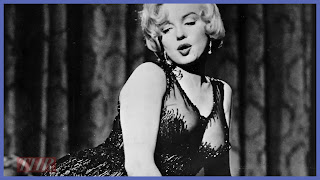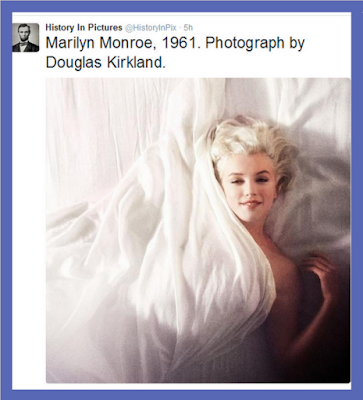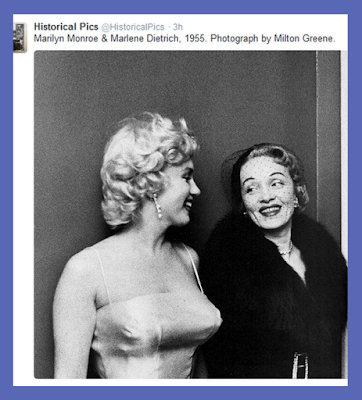The words icon and legend may be two of the most overused when discussing celebrities, but in a few cases it is warranted.
Marilyn Monroe is one of the true icons of the 20th century: instantly recognisable, constantly celebrated, often analysed, rarely understood. Her death at 36 only added to her allure; to think she would have turned 90 this coming June 1 is almost inconceivable. It’s impossible to imagine this woman ever succumbing to the ravages of age, given how perfectly preserved she is in the collective memory.
Her
continuing popularity and enduring mystique mean that it shouldn’t be
surprising that not one but two exhibitions celebrating Monroe are about
to open in regional galleries. Bendigo Art Gallery, in collaboration
with 20th Century Fox, launches Marilyn Monroe on March 5 (its
previous exhibition on Grace Kelly in 2012 was a record breaker for the
institution). The Murray Art Museum Albury opens Marilyn: Celebrating an American Icon next Friday, February 12.
A uniting feature of both exhibitions is her incredible visual impact, an integral part of her enduring mystique.
While her look is much mimicked — the platinum hair, the red pout, the arched brows — her style and fashion played an important supporting role in both her rise to fame, and in underpinning the duality of her persona that was much talked about during her life and since her death in 1962.
She was born Norma Jeane Mortenson (the name on her birth certificate) in 1926, changing her name to Marilyn Monroe 20 years later when she was first signed with 20th Century Fox; she rose to fame playing the “dumb blonde” in films such as Gentlemen Prefer Blondes and How to Marry a Millionaire, but was known to be highly intelligent; she was a creation of the studio machine, her career seemingly at the whim of directors and studio heads, but she managed to break free and create her own production company, Marilyn Monroe Productions, in order to have more control over her projects.
Her highly sexualised image and costumes helped propel her career, but off duty her fashion choices reflected someone much more demure and quietly sensual.
“Costume is a great connector,” says Bendigo director Karen Quinlan. “And the fashion of the day, that’s what we’re capturing here, a moment in time. When you look at her wardrobe, what she felt comfortable in alongside what she was told to wear and this other construction of her identity, I love that. But it’s great to know more, that’s our thirst for knowledge. I think this exhibition is going to be great for that reason.”
Exhibition curator Tansy Curtin agrees that fashion was a secondary element to her allure and identity, albeit an important one.
“It’s interesting because it’s not the first thing you think of when you think of Marilyn Monroe,” Curtin tells The Australian — unlike, perhaps Audrey Hepburn, who is consistently cited as a fashion icon ahead of movie star by many today. “There are the iconic dresses, the white subway dress, for example, but you think about Marilyn the person before the costumes or clothing she wore.
“What
we’ve tried to do in the exhibition is show two sides, her public
wardrobe and film costumes, which were overtly sensual and glamorous and
reveal as much as conceal. Whereas her personal clothing is much more
demure in a way: simple black cocktail dresses and wiggle dresses, of
course, you can see her hourglass figure but not in an overt way.
There’s a duality in the fashion persona of Marilyn.”
The white halterneck design worn in The Seven Year Itch, in which she stands over a subway grating so that its skirt billows about her, is also by Travilla, and is represented in a sketch for the design, and in a number of photographs in the MAMA exhibition. The dress and that moment loom large in our memory of Monroe — as does Seward Johnson’s sculpture Forever Marilyn, an enormous eight-metre, 15-tonne creation that is now standing in Bendigo, its first showing outside the US.
Australian-born costume designer Orry-Kelly understood her allure; he designed her wardrobe for Some Like It Hot, most spectacularly a dress she wears to sing I Wanna Be Loved by You. From a distance she looks naked bar a smattering of carefully placed sequins on tulle (a photograph of Marilyn in the dress is in Bendigo).
Conversely, the Bendigo exhibition also includes two particularly notable personal looks. “We have the little green Pucci blouse, which was quite understated, and was the last thing that Marilyn was photographed publicly in, so it’s quite poignant,” says Curtin. There is also a photo of the star in a red cotton housecoat, with a pattern of chickens and roosters. “It’s quite ordinary, housewifey,” says Curtin. “It was worn when she was about two months’ pregnant (to third husband Arthur Miller). You can see in the photo she looks quite proud, but sadly she lost the baby. But that human side of Marilyn gives us some insight that we don’t usually get to see.”
For Bianca Acimovic, curator of the MAMA exhibition, those two sides of Monroe were never fully reconciled, and she invited a whole new level of public fascination in her every move.
“Marilyn had these two roles — Norma
Jeane, who was the everyday person, and she became Marilyn Monroe, this
fictional, created person that was all styled in fashion and told how to
act and how to behave.
“She transcended into being Marilyn Monroe but her internal persona never adjusted to it.”
Marilyn Monroe is at Bendigo Art Gallery, March 5 to July 10. Marilyn: Celebrating an American Icon is at Murray Art Museum Albury, February 12 to May 8.
With many thanks to The Australian
Some related posts:
Marilyn Monroe's 'Happy Birthday, Mr. President' Dress Sells for $4.8 Million
Never Ever Give Up! - Famous Failures
Daniel Day-Lewis Receives A Knighthood
Marilyn Monroe's Belongings Up For Auction
Burt Bacharach Brings Back The Hits: From Marlene Dietrich to Glastonbury
How Sergio Leone’s Westerns Changed Cinema
Top 10 Movie Twists of All Time
Oscar Winners 2016: The Full List
The Importance of Costume in Films: Some
Iconic Images of our Culture
Could Marilyn Monroe Star In A New Film?
Do You See Albert Einstein Or Marilyn Monroe In This Photo?
Some Like It Hot - Still!
25 Most Influential People In History By Attribute
Elizabeth Taylor Quotes
Biopics
Now Focus On Key Moments Rather Than A Whole Life
Famous Blondes, From Monroe and Novak To Bardot And Basinger
Gene Wilder: Master Of Comedy
Clint
Eastwood's Latest Biopic - Sully
10 Historical Movies That Mostly Get It Right
Long-Lost Peter Sellers Films Found In Rubbish Skip
Are These The Top 10 Comedy Actors of All Time?
Could Marilyn Monroe Star In A New Film?
Do You See Albert Einstein Or Marilyn Monroe In This Photo?
Some Like It Hot - Still!
25 Most Influential People In History By Attribute
Elizabeth Taylor Quotes
Florence Foster Jenkins: Meryl Streep's Latest Biopic
Citizen Kane: Orson Welles’s Masterpiece, As A 1941 NYT Critic Saw It
"The Man Who Knew Infinity" Review - Jeremy Irons And Dev Patel
New Book: Mom In The Movies By Richard Corliss
The 100 Greatest American Films
Loving Vincent: The World's First Fully Painted Film
Dean Martin: 99 Years Of His Music and Movies
The Lasting Legacy Of The Good, The Bad And the Ugly
Are These The Top 10 Songs Named After Famous People?
Marilyn Monroe: Her Secret Diary
Citizen Kane: Orson Welles’s Masterpiece, As A 1941 NYT Critic Saw It
"The Man Who Knew Infinity" Review - Jeremy Irons And Dev Patel
New Book: Mom In The Movies By Richard Corliss
The 100 Greatest American Films
Loving Vincent: The World's First Fully Painted Film
Dean Martin: 99 Years Of His Music and Movies
The Lasting Legacy Of The Good, The Bad And the Ugly
Are These The Top 10 Songs Named After Famous People?
Marilyn Monroe: Her Secret Diary
Jennifer Saunders And Joanna Lumley Return In Absolutely Fabulous The Movie
The Rolling Stones: A New Movie About The Making of 'Exile on Main Street'
The Rolling Stones: A New Movie About The Making of 'Exile on Main Street'
Famous Blondes, From Monroe and Novak To Bardot And Basinger
Gene Wilder: Master Of Comedy
10 Historical Movies That Mostly Get It Right
Long-Lost Peter Sellers Films Found In Rubbish Skip
Are These The Top 10 Comedy Actors of All Time?
Happy Birthday, Julie Andrews!
Happy Birthday Dame Angela Lansbury!
Happy Birthday Grace Kelly!
Kirk Douglas Turns 100 After Seven Decades Of Film















